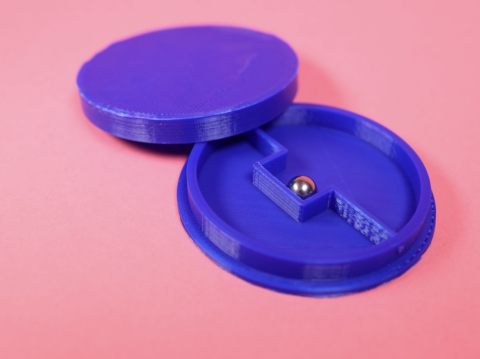Mystery Boxes

Experiment with mystery boxes to learn about different aspects of nature of science.
Description
Mystery boxes are a great tool to practise scientific reasoning skills and understand the power of scientific models. Participants develop hypotheses about the internal structure of a mystery box and come up with ideas on how to test their hypotheses.
Below, we present ideas for mystery box activities, during which we introduce the role of theoretical predictions in science, the role of and the difference between scientific observations and inferences, how scientific models evolve in light of new discoveries, and that science is a social endeavour.
Similarly to mystery boxes, scientists at CERN are aiming to understand the structure of the universe by developing theoretical models and performing complex experiments to confirm or refute their hypotheses. You can learn more about CERN’s research programme here.
Material list
Here, we present a 3D-printable setup. For a LEGO and a cardboard alternative, have a look at our ideas for educators and related resources at the end of this page. The 3D-printable setup consists of:
- Base: a 3D-printable circular base with various options of internal structures (e.g. square, triangle, etc.). You can find the 3D-printing instructions here.
- Steel ball: 5 mm diameter, is placed inside the structure in the base, needs to be purchased separately (look for a shop selling ball bearings).
- Lid: a 3D-printable lid to close the mystery box, we recommend glueing it onto the base.
- Small neodymium rod magnet: for more accurate observations, optional. ( As an example, the magnet S-05-14-N fits well inside the box. )
Instructions
- Prepare a few mystery boxes with internal structures: triangle, square, line, or an empty base.
- Randomly select one mystery box and try to come up with a model of its structure, by observing the sound the ball makes when moving the box. Draw your model on paper.
- Come up with ideas to test your model. These ideas should be predictions about the behaviour of the box in a certain experiment, based on your model. For example: “If there is a square inside, I should hear 4 clicking sounds when I turn the mystery box one full turn.”
- Test your predictions and note down your observations. If needed, improve your models if the predictions did not match your observations and draw your improved model on paper.
- If you have a small rod magnet, you can use it to perform more accurate measurements, as the small rod magnet will attract the steel ball if it is close enough. You will therefore feel if the steel ball cannot be pulled in a certain part of the base because there is a hidden wall.
We know it’s tempting but NEVER open the mystery box, that’s not how science works. If you cannot resist the temptation, glue the box together (that's what we did).
Ideas for educators
There are different ways to use mystery boxes in your classroom, depending on the age and level of your students.
- If you don't have access to a 3D-printer, you can build mystery boxes out of LEGO instead. The following paper provides instructions on how to assemble the mystery box, together with classroom activities through which students explicitly learn about different aspects of nature of science, such as that science is empirical and inferential, science is tentative, science is creative, and many more! Horvat, A. K., Boselli, M., et al. The mystery box challenge: explore the nature of science Teach article.
- The discovery of the Higgs boson in 2012 provides a prime example of modern science in the making and a fantastic opportunity to discuss important aspects of nature of science in the classroom. Find ideas about how to link mystery boxes to the discovery of the Higgs boson, through discussing about nature of science: Woithe, J., Boselli, M., et al. (2022). Higgs in a box: investigating the nature of a scientific discovery. The Physics Educator, 4(04), 2250019.
Related resources
- Instead of our 3D-printable or LEGO boxes, you can also build your own Water Mystery Box of the Exploratorium.
- You can use cardboard tubes (e.g. empty toilet paper tubes) and connect two ropes inside in different ways. If you are looking for building instructions and a lesson plan for a mystery tube activity, check out the education resource The Black Box created by the Perimeter Institute, or the Mystery Tube activity created by the Science Museum Group. Here’s a short video demonstrating the mystery tube: Mystery tube activity video.
- For another activity about observation and inference, check out the Perimeter Institute resource Making Models: Wooden Blocks.